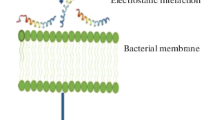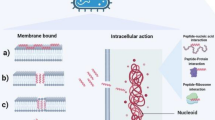Abstract
Naturally occurring antimicrobial peptides (AMPs) present several drawbacks that strongly limit their development into therapeutically valuable antibiotics. These include susceptibility to protease degradation and high costs of manufacture. To overcome these problems, researchers have tried to develop mimics or peptidomimetics endowed with better properties, while retaining the basic features of membrane-active natural AMPs such as cationic charge and amphipathic design. Protein epitope mimetics, multimeric (dendrimeric) peptides, oligoacyllysines, ceragenins, synthetic lipidated peptides, peptoids and other foldamers are some of the routes explored so far. The synthetic approach has led to compounds that have already entered clinical evaluation for the treatment of specific conditions, such as Staphylococcus (MRSA) infections. Should these trials be successful, an important proof-of-concept would be established, showing that synthetic oligomers rather than naturally occurring molecules could bring peptide-based antibiotics to clinical practice and the drug market for local and systemic treatment of medical conditions associated with multi-drug resistant pathogens.









Similar content being viewed by others
Abbreviations
- AMP:
-
Antimicrobial peptide
- MAP:
-
Multiple antigenic peptide
- LPS:
-
Lipopolysaccharide
- LTA:
-
Lipoteichoic acid
- OAK:
-
Oligoacyllysine
- PEM:
-
Protein epitope mimetic
- ROMP:
-
Ring-opening metathesis polymerization
- SMAMP:
-
Synthetic mimic of antimicrobial peptides
- VV:
-
Vaccinia virus
References
Giuliani A, Rinaldi AC (2010) Antimicrobial peptides. Methods and protocols. Methods in molecular biology, vol 618. Humana Press, New York
van ‘t Hof W, Veerman EC, Helmerhorst EJ, Amerongen AV (2001) Antimicrobial peptides: properties and applicability. Biol Chem 382:597–619
Rotem S, Mor A (2009) Antimicrobial peptide mimics for improved therapeutic properties. Biochim Biophys Acta 1788:1582–1592
Tzeng Y-L, Ambrose KA, Zughaier S, Zhou X, Miller YK, Shafer WM, Stephens DS (2005) Cationic antimicrobial peptide resistance in Neisseria meningitidis. J Bacteriol 187:5387–5396
Kraus D, Peschel A (2006) Molecular mechanisms of bacterial resistance to antimicrobial peptides. Curr Top Microbiol Immunol 306:231–250
Kraus D, Peschel A (2008) Staphylococcus aureus evasion of innate antimicrobial defense. Future Microbiol 3:437–451
Bessalle R, Kapitkovsky A, Gorea A, Shalit I, Fridkin M (1990) All-d-magainin: chirality, antimicrobial activity and proteolytic resistance. FEBS Lett 274:151–155
Giuliani A, Pirri G, Bozzi A, Di Giulio A, Aschi M, Rinaldi AC (2008) Antimicrobial peptides: natural templates for synthetic membrane-active compounds. Cell Mol Life Sci 65:2450–2460
Tam JP, Spetzler JC (2001) Synthesis and application of peptide dendrimers as protein mimetics. Curr Protoc Protein Sci. Chapter 18:Unit 18.5
Tam JP (1988) Synthetic peptide vaccine design: synthesis and properties of a high density multiple antigenic peptide system. Proc Natl Acad Sci USA 85:5409–5413
Pini A, Giuliani A, Falciani C, Runci Y, Ricci C, Lelli B, Malossi M, Neri P, Rossolini GM, Bracci L (2005) Antimicrobial activity of novel dendrimeric peptides obtained by phage display selection and rational modification. Antimicrob Agents Chemother 49:2665–2672
Bruschi M, Pirri G, Giuliani A, Nicoletto SF, Baster I, Scorciapino MA, Casu M, Rinaldi AC (2010) Synthesis, characterization, antimicrobial activity and LPS-interaction properties of SB041, a novel dendrimeric peptide with antimicrobial properties. Peptides 31:1459–1467
Pini A, Falciani C, Mantengoli E, Bindi S, Brunetti J, Iozzi S, Rossolini GM, Bracci L (2010) A novel tetrabranched antimicrobial peptide that neutralizes bacterial lipopolysaccharide and prevents septic shock in vivo. FASEB J 24:1015–1022
Falciani C, Lozzi L, Pini A, Corti F, Fabbrini M, Bernini A, Lelli B, Niccolai N, Bracci L (2007) Molecular basis of branched peptides resistance to enzyme proteolysis. Chem Biol Drug Des 69:216–221
Luganini A, Giuliani A, Pirri G, Pizzuto L, Landolfo S, Gribaudo G (2010) Peptide-derivatized dendrimers inhibit human cytomegalovirus infection by blocking virus binding to cell surface heparan sulphate. Antiviral Res 85:532–540
Obrecht D, Robinson JA, Bernardini F, Bisang C, DeMarco SJ, Moehle K, Gombert FO (2009) Recent progress in the discovery of macrocyclic compounds as potential anti-infective therapeutics. Curr Med Chem 16:42–65
Lou K (2010) A new spin on protegrin. SciBX 3: doi:10.1038/scibx.2010.265
Srinivas N, Jetter P, Ueberbacher BJ, Werneburg M, Zerbe K, Steinmann J, Van der Meijden B, Bernardini F, Lederer A, Dias RL, Misson PE, Henze H, Zumbrunn J, Gombert FO, Obrecht D, Hunziker P, Schauer S, Ziegler U, Käch A, Eberl L, Riedel K, DeMarco SJ, Robinson JA (2010) Peptidomimetic antibiotics target outer-membrane biogenesis in Pseudomonas aeruginosa. Science 327:1010–1013
Jiang L, Moehle K, Dhanapal B, Obrecht D, Robinson JA (2000) Combinatorial biomimetic chemistry: parallel synthesis of a small library of β-hairpin mimetics based on loop III from human platelet-derived growth factor. Helv Chim Acta 83:3097–3112
Robinson JA, Demarco S, Gombert F, Moehle K, Obrecht D (2008) The design, structures and therapeutic potential of protein epitope mimetics. Drug Discov Today 13:944–951
Radzishevsky IS, Rotem S, Bourdetsky D, Navon-Venezia S, Carmeli Y, Mor A (2007) Improved antimicrobial peptides based on acyl-lysine oligomers. Nat Biotechnol 25:657–659
Rotem S, Radzishevsky IS, Bourdetsky D, Navon-Venezia S, Carmeli Y, Mor A (2008) Analogous oligo-acyl-lysines with distinct antibacterial mechanisms. FASEB J 22:2652–2661
Rotem S, Raz N, Kashi Y, Mor A (2010) Bacterial capture by peptide-mimetic oligoacyllysine surfaces. Appl Environ Microbiol 76:3301–3307
Sarig H, Livne L, Held-Kuznetsov V, Zaknoon F, Ivankin A, Gidalevitz D, Mor A (2010) A miniature mimic of host defense peptides with systemic antibacterial efficacy. FASEB J 24:1904–1913
Sarig H, Rotem S, Ziserman L, Danino D, Mor A (2008) Impact of self-assembly properties on antibacterial activity of short acyl-lysine oligomers. Antimicrob Agents Chemother 52:4308–4314
Moore KS, Wehrli S, Roder H, Rogers M, Forrest JN Jr, McCrimmon D, Zasloff M (1993) Squalamine: an aminosterol antibiotic from the shark. Proc Natl Acad Sci USA 90:1354–1358
Epand RF, Savage PB, Epand RM (2007) Bacterial lipid composition and the antimicrobial efficacy of cationic steroid compounds (Ceragenins). Biochim Biophys Acta 1768:2500–2509
Savage PB, Li C, Taotafa U, Ding B, Guan Q (2002) Antibacterial properties of cationic steroid antibiotics. FEMS Microbiol Lett 217:1–7
Isogai E, Isogai H, Takahashi K, Okumura K, Savage PB (2009) Ceragenin CSA-13 exhibits antimicrobial activity against cariogenic and periodontopathic bacteria. Oral Microbiol Immunol 24:170–172
Leszczyńska K, Namiot A, Fein DE, Wen Q, Namiot Z, Savage PB, Diamond S, Janmey PA, Bucki R (2009) Bactericidal activities of the cationic steroid CSA-13 and the cathelicidin peptide LL-37 against Helicobacter pylori in simulated gastric juice. BMC Microbiol 9:187
Graham DY, Shiotani A (2008) New concepts of resistance in the treatment of Helicobacter pylori infections. Nat Clin Pract Gastroenterol Hepatol 5:321–331
Howell MD, Streib JE, Kim BE, Lesley LJ, Dunlap AP, Geng D, Feng Y, Savage PB, Leung DY (2009) Ceragenins: a class of antiviral compounds to treat orthopox infections. J Invest Dermatol 129:2668–2675
Liu DH, Choi S, Chen B, Doerksen RJ, Clements DJ, Winkler JD, Klein ML, DeGrado WF (2004) Nontoxic membrane-active antimicrobial arylamide oligomers. Angew Chem Int Ed 43:1158–1162
Scott RW, DeGrado WF, Tew GN (2008) De novo designed synthetic mimics of antimicrobial peptides. Curr Opin Biotechnol 19:620–627
Ishitsuka Y, Arnt L, Majewski J, Frey S, Ratajczek M, Kjaer K, Tew GN, Lee KYC (2006) Amphiphilic poly(phenyleneethynylene)s can mimic antimicrobial peptide membrane disordering effect by membrane insertion. J Am Chem Soc 128:13123–13129
Lienkamp K, Madkour AE, Kumar KN, Nüsslein K, Tew GN (2009) Antimicrobial polymers prepared by ring-opening metathesis polymerization: manipulating antimicrobial properties by organic counterion and charge density variation. Chemistry 15:11715–11722
Lienkamp K, Tew GN (2009) Synthetic mimics of antimicrobial peptides–a versatile ring-opening metathesis polymerization based platform for the synthesis of selective antibacterial and cell-penetrating polymers. Chemistry 15:11784–11800
Haug BE, Stensen W, Kalaaij M, Rekdal Ø, Svendsen JS (2008) Synthetic antimicrobial peptidomimetics with therapeutic potential. J Med Chem 51:4306–4314
Flemming K, Klingenberg C, Cavanagh JP, Sletteng M, Stensen W, Svendsen JS, Flaegstad T (2009) High in vitro antimicrobial activity of synthetic antimicrobial peptidomimetics against staphylococcal biofilms. J Antimicrob Chemother 63:136–145
Shalev DE, Rotems S, Fish A, Mor A (2006) Consequences of N-acylation on structure and membrane binding properties of dermaseptin derivative K4–S4-(1–13). J Biol Chem 281:9432–9438
Makovitzki A, Avrahami D, Shai Y (2006) Ultrashort antibacterial and antifungal lipopeptides. Proc Natl Acad Sci USA 103:15997–16002
Vallon-Eberhard A, Makovitzki A, Beauvais A, Latgé JP, Jung S, Shai Y (2008) Efficient clearance of Aspergillus fumigatus in murine lungs by an ultrashort antimicrobial lipopeptide, palmitoyl-Lys-Ala-dAla-Lys. Antimicrob Agents Chemother 52:3118–3126
Laverty G, McLaughlin M, Shaw C, Gorman SP, Gilmore BF (2010) Antimicrobial activity of short, synthetic cationic lipopeptides. Chem Biol Drug Des 75:563–569
Zuckermann RN, Kerr JM, Kent SBH, Moos WH (1992) Efficient method for the preparation of peptoids [oligo(N-substituted glycines)] by submonomer solid-phase synthesis. J Am Chem Soc 114:10646–10647
Olsen CA (2010) Peptoid–peptide hybrid backbone architectures. Chem Bio Chem 11:152–160
Chongsiriwatana NP, Patch JA, Czyzewski AM, Dohm MT, Ivankin A, Gidalevitz D, Zuckermann RN, Barron AE (2008) Peptoids that mimic the structure, function, and mechanism of helical antimicrobial peptides. Proc Natl Acad Sci USA 105:2794–2799
Uchida M, McDermott G, Wetzler M, Le Gros MA, Myllys M, Knoechel C, Barron AE, Larabell CA (2009) Soft X-ray tomography of phenotypic switching and the cellular response to antifungal peptoids in Candida albicans. Proc Natl Acad Sci USA 106:19375–19380
Ryge TS, Frimodt-Møller N, Hansen PR (2008) Antimicrobial activities of twenty lysine-peptoid hybrids against clinically relevant bacteria and fungi. Chemotherapy 54:152–156
Schmitt MA, Weisblum B, Gellman SH (2004) Unexpected relationships between structure and function in alpha, beta-peptides: antimicrobial foldamers with heterogeneous backbones. J Am Chem Soc 126:6848–6849
Schmitt MA, Weisblum B, Gellman SH (2007) Interplay among folding, sequence, and lipophilicity in the antibacterial and hemolytic activities of alpha/beta-peptides. J Am Chem Soc 129:417–428
Mowery BP, Lee SE, Kissounko DA, Epand RF, Epand RM, Weisblum B, Stahl SS, Gellman SH (2007) Mimicry of antimicrobial host-defense peptides by random copolymers. J Am Chem Soc 129:15474–15476
Epand RF, Mowery BP, Lee SE, Stahl SS, Lehrer RI, Gellman SH, Epand RM (2008) Dual mechanism of bacterial lethality for a cationic sequence-random copolymer that mimics host-defense antimicrobial peptides. J Mol Biol 379:38–50
Li X, Li Y, Han H, Miller DW, Wang G (2006) Solution structures of human LL-37 fragments and NMR-based identification of a minimal membrane-targeting antimicrobial and anticancer region. J Am Chem Soc 128:5776–5785
Mowery BP, Lindner AH, Weisblum B, Stahl SS, Gellman SH (2009) Structure-activity relationships among random nylon-3 copolymers that mimic antibacterial host-defense peptides. J Am Chem Soc 131:9735–9745
Brogden KA (2005) Antimicrobial peptides: pore formers or metabolic inhibitors in bacteria? Nat Rev Microbiol 3:238–250
Hale JD, Hancock REW (2007) Alternative mechanisms of action of cationic antimicrobial peptides on bacteria. Expert Rev Anti Infect Ther 5:951–959
Cho JH, Kim SC (2010) Non-membrane targets of antimicrobial peptides: novel therapeutic opportunities? In: Wang G (ed) Antimicrobial peptides: discovery, design and novel therapeutic strategies. Oxfordshire, England, pp 128–140
Gabriel GJ, Madkour AE, Dabkowski JM, Nelson CF, Nüsslein K, Tew GN (2008) Synthetic mimic of antimicrobial peptide with nonmembrane-disrupting antibacterial properties. Biomacromolecules 9:2980–2983
Hennig A, Gabriel GJ, Tew GN, Matile S (2008) Stimuli-responsive polyguanidino-oxanorbornene membrane transporters as multicomponent sensors in complex matrices. J Am Chem Soc 130:10338–10344
Giuliani A, Pirri G, Nicoletto SF (2007) Antimicrobial peptides: an overview of a promising class of therapeutics. Centr Eur J Biol 2:1–33
Ross NT, Katt WP, Hamilton AD (2010) Synthetic mimetics of protein secondary structure domains. Phil Trans R Soc A 368:989–1008
Conflict of interest
One of the authors declares competing financial interests. Andrea Giuliani is an executive board member and minor shareholder of Spider Biotech S.r.l. (www.spiderbiotech.com), which is developing peptide-based anti-infectives.
Author information
Authors and Affiliations
Corresponding author
Rights and permissions
About this article
Cite this article
Giuliani, A., Rinaldi, A.C. Beyond natural antimicrobial peptides: multimeric peptides and other peptidomimetic approaches. Cell. Mol. Life Sci. 68, 2255–2266 (2011). https://doi.org/10.1007/s00018-011-0717-3
Received:
Revised:
Accepted:
Published:
Issue Date:
DOI: https://doi.org/10.1007/s00018-011-0717-3




